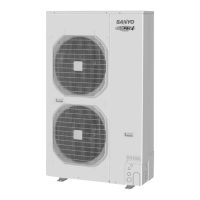2
2-27
XM Type (for Link Wiring)
2-27. Caution
This unit may be used in a single-type refrigerant
system where 1 outdoor unit is connected to 1 in-
door unit, and also in a system where 1 outdoor unit
is connected to multiple indoor units (maximum 4
< Double-Twin >).
This test run explanation describes primarily the
procedure when using the wired remote controller.
If link wiring is used, set the outdoor unit system address
to allow the combination of indoor and outdoor units to be
identified. At the same time, indicate the indoor-outdoor
unit combination number in a location where it can be
checked easily (near the indoor unit nameplates).
(This number will be required for subsequent maintenance.
Refer to 2-32-2, -3, -4.)
Request that the customer be present when the test run
is performed. At this time, explain the operation manual
and have the customer perform the actual steps.
Be sure to pass the manuals and warranty certificate to
the customer.
Check that the 220 – 240 V AC wiring is not connected
to the inter-unit control wiring connector terminal.
If 220 – 240 V AC is accidentally applied, the indoor or
outdoor unit control PCB fuse will blow in order to protect
the PCB. Correct the wiring connections, then disconnect
the 2P connectors (blue, OC) that are connected to the
PCB, and replace them with 2P connectors (brown, EMG).
(Refer to the figure 2-27.)
If operation is still not possible after changing the brown
connectors, cut the JP003 for the indoor unit, and cut the
JP007 for the outdoor unit.
(Be sure to turn the power OFF before performing this
work.)
Indoor unit control PCB
Fuse 5A
CHK(2P plug)
2P connector (brown)
2P connector (b
lue)
JP003
Power PCB
Control PCB
LED1
FUSE (0.5A, F500)
OC (CN500, BLU)
MOV2
(CN301, BLK)
MOV1
(CN300, WHT)
EMG (CN502, BRN)
SILENT (CN037, WHT)
PUMP DOWN (CN048)
TEMINAL (CN205, BLK)
R.C.ADD. Rotary switch
C2 (CN020, WHT)
C1 (CN021, WHT)
TEST (CN033, RED)
TD (CN024, BLK)
TO (CN023, BLK)
TS (CN022, RED)
63PH (CN027, WHT)
EXCT
(CN030, RED)
RC P
(CN039, RED)
IC002
CTL2
(CN202, GRN)
CTL1
(CN203, GRN)
FUSE
(6.3A, F101)
N.P.CHECK
(CN046, RED)
LED2
MODE (CN038)
D115
IC001
R.C.ADD. DIP switch
A.ADD (CN047)
C-CHK (CN035)
EEPROM
LED (D041)
Fig. 2-27
2-28. Test Run Procedure
YES
NO
YES
YES
NO
NO
Fig. 2-28
Outdoor unit control PCB
Recheck the items to check
before the test run.
(See 2-29)
Check the combination (wiring) of
indoor and outdoor units.
(See 2-32-1)
Is system “single-type”?
Is group control with multiple
outdoor units used?
(See 2-32-2) How to Set the
Outdoor Unit System Address
Set the outdoor unit system
address.
(See 2-32-1) How to Set
Automatic Address
Set the automatic address
setting from outside unit or
remote controller.
(*) Indicate (mark) the combination number.
(See 2-32-3, -4)
Turn ON the indoor and outdoor power.
Automatic Address
Set the remote controller to
“test run”.
(See 2-30)
Can
operation be
started?
Return the remote controller
to normal control.
Turn ON the
indoor and
outdoor power.
Automatic
Address
(See 2-31)
Refer to “Table of
Self-Diagnostic
Functions” to check
the system.
In addition, refer to
2-32 and correct any
items that need to be
corrected.
Note: Check the indoor-
side drainage.
(*) Required for
simultaneous-operation
multi systems and for
group control.
SM830161Book.indb27SM830161Book.indb27 2008/06/039:09:042008/06/039:09:04

